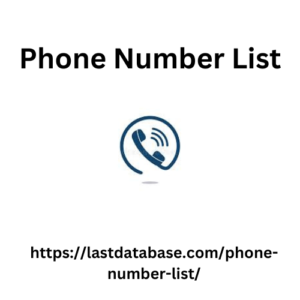Dialing Out: Unveiling the in the Digital Age
In our hyper-connected world, the ability to make an outgoing call remains essential. Whether it’s connecting with loved ones, conducting business, or reaching emergency services, understanding outgoing calls empowers seamless communication. This comprehensive guide delves into the world of outgoing calls, navigating the technical aspects and exploring their relevance in today’s digital landscape.
Decoding the Dial Tone: The Anatomy of an Outgoing Call
An outgoing call initiates communication by transmitting a signal from your phone to a designated phone number. Here’s a breakdown of the process:
- Dialing the Number: You enter Cell phone number list uganda the phone number using a keypad or touchscreen on your phone.
- Network Connection: Your phone transmits a signal containing the dialed digits to your mobile network provider (carrier) through cell towers or landline infrastructure.
- Routing and Switching: The The Importance of Cell Phone Numbers network provider routes the call based on the dialed number. This involves identifying the recipient’s network and establishing a connection.
- Ringing and Connecting: The recipient’s phone rings, and upon answering, a two-way audio connection is established, allowing for conversation.
Beyond the Basics: Types of Outgoing Calls
There are several ways to categorize outgoing calls:
- Landline Calls: Traditional phone calls made using a landline phone connected to a physical network.
- Mobile Phone Calls: Outgoing calls made using a mobile phone that connects to the network through cell towers.
- International Calls: Calls placed to phone numbers in a different country, often requiring additional dialing codes and potentially incurring higher charges.
- Toll-Free Calls: Calls to phone numbers with a prefix that doesn’t incur charges for the caller, typically used by businesses for customer service.
- Conference Calls: Calls involving three or more participants connected simultaneously through a dedicated service or app.
- Video Calls: Outgoing calls that utilize video technology, allowing for visual communication alongside voice.
The Call of Convenience: Benefits of Outgoing Calls
Despite the rise of alternative communication methods, outgoing calls offer distinct advantages:
- Universality: Phone networks are widespread, making outgoing calls a reliable way to connect with anyone with a phone number.
- Simplicity: Outgoing calls are straightforward to initiate, requiring minimal technical knowledge.
- Clarity: Voice calls provide clear audio communication, ideal for conveying complex information or expressing emotions.
- Security: Depending on the network and service providers, calls can offer a level of privacy compared to some online communication methods.
The Digital Age and Outgoing Calls: A Shifting Landscape
The digital age has introduced alternative communication methods that influence how we make outgoing calls:
- Mobile Applications: Messaging apps like WhatsApp and Viber enable free or low-cost voice calls over an internet connection.
- Video Conferencing Platforms: Zoom, Google Meet, and Microsoft Teams offer video conferencing capabilities for meetings or connecting with loved ones visually.
- Social Media Integration: Some social media platforms allow voice and video calls directly within the app.
The Rise of Integration: Modern phones and communication apps often integrate outgoing calls with other features. Imagine searching for a business online and initiating a call directly from their website, or sending a text message to a contact and then seamlessly switching to a voice call.
So, When Do You Make an Outgoing Call?
The choice between an outgoing call and alternative methods depends on several factors:
- Urgency: For urgent communication, outgoing calls offer immediate connection compared to waiting for a text reply.
- Nature of Communication: For complex conversations or conveying emotions, voice calls can be more effective than text-based communication.
- Cost: Consider potential charges associated with outgoing calls, especially for international calls or calls to toll-free numbers.
- Technology Access: Not everyone has reliable internet access, making outgoing calls a more practical option in certain situations.
Conclusion: The Enduring Relevance of Outgoing Calls
While the digital age has introduced exciting new communication methods, outgoing calls remain a vital tool in our communication arsenal. Understanding the technology behind them, their various forms, and their place in the digital landscape empowers you to choose the most effective way to connect, ensuring seamless communication in a world brimming with information and connection. So, pick up the phone (or your mobile device), dial that number, and get ready to connect!



